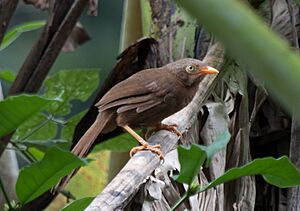Orange-billed babbler facts for kids
Quick facts for kids Orange-billed babbler |
|
|---|---|
 |
|
| at Kelani Forest Reserve, Sri Lanka | |
| Conservation status | |
| Scientific classification | |
| Synonyms | |
|
Turdoides rufescens |
The orange-billed babbler (Argya rufescens) is a special bird found only in Sri Lanka. It's also called the Ceylon rufous babbler or Sri Lankan rufous babbler. This bird belongs to a family called Leiothrichidae, which includes many types of babblers.
In the past, some people thought it was just a type of jungle babbler. But now we know it's its own unique species!
Contents
Where Orange-Billed Babblers Live
This bird loves to live in rainforests. You'll rarely see it outside of thick jungle areas. Like most babblers, it doesn't migrate (travel long distances). It has short, rounded wings, so it's not a strong flyer.
Even though its home is sometimes threatened, you can find the orange-billed babbler in all the forests of Sri Lanka's wet zone. It's quite common in places like Kitulgala and Sinharaja.
What Orange-Billed Babblers Look Like
These birds are mostly orange-brown on their undersides. Their backs are a little darker. The top of their head and the back of their neck are grey. And, as their name suggests, they have a bright orange beak!
Orange-Billed Babbler Life and Habits
Orange-billed babblers live in groups, usually with seven to ten or even more birds. They are very noisy! You can often hear a flock from far away because of their constant chattering, squeaking, and chirping sounds. If you hear them, it's often a sign that a group of different bird species, called a mixed-species feeding flock, is nearby. These mixed flocks are common in Asian wet forests.
These babblers mainly eat insects. They also enjoy eating berries found in the jungle.
Orange-Billed Babblers in Culture
In Sri Lanka, people call this bird rathu demalichcha in the Sinhala language. This name means 'red babbler'.
This special bird has even appeared on a 10 rupee Sri Lankan postal stamp. It also shows up on the 100 Sri Lankan rupee bank note from the 2010 series.


